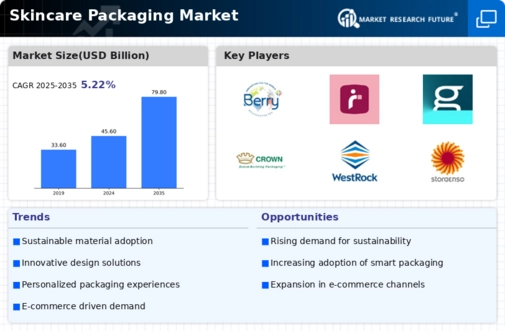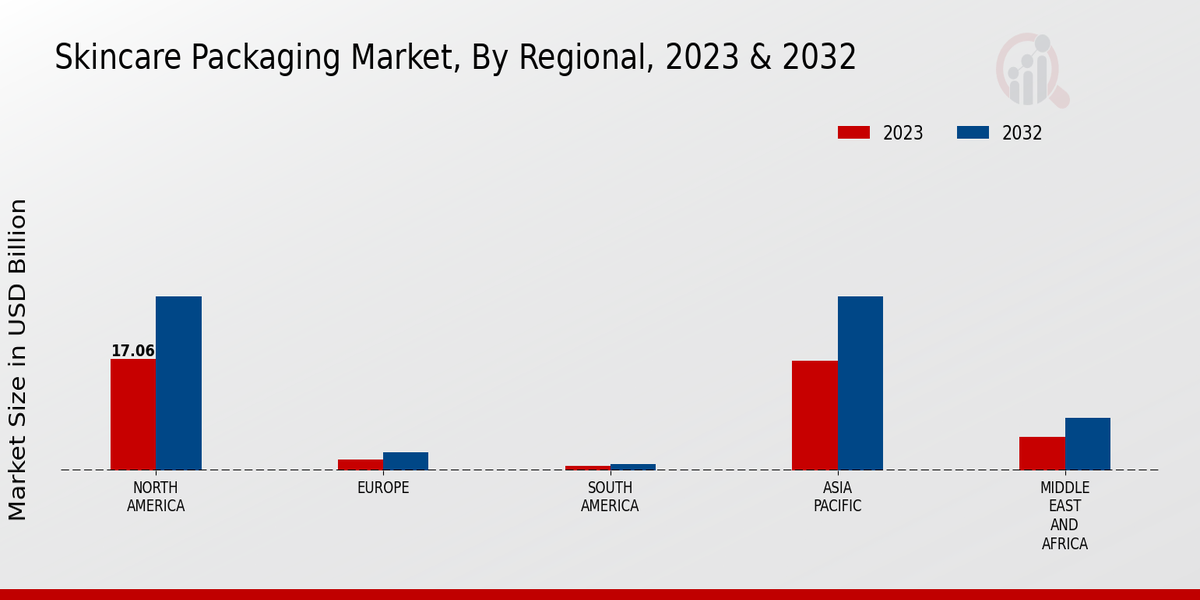E-commerce Growth
The rise of e-commerce significantly impacts the Global Skincare Packaging Market Industry, as online shopping becomes the preferred method for consumers. This shift necessitates packaging that is not only visually appealing but also functional and protective during transit. Brands are investing in packaging solutions that ensure product integrity while enhancing the unboxing experience for consumers. The convenience of online shopping is driving demand for innovative packaging designs that cater to this market segment. Consequently, the industry is poised for growth, with projections indicating a market value of 45.6 USD Billion in 2024, underscoring the importance of e-commerce in shaping packaging strategies.
Regulatory Compliance
Regulatory compliance is a critical driver in the Global Skincare Packaging Market Industry, as governments worldwide implement stringent regulations regarding packaging materials and labeling. Brands must navigate these regulations to ensure their products meet safety and environmental standards. Compliance not only protects consumers but also enhances brand reputation. As regulations evolve, companies are compelled to invest in research and development to create compliant packaging solutions. This focus on regulatory adherence is likely to influence market dynamics and contribute to the industry's growth trajectory, particularly as it approaches a projected value of 79.8 USD Billion by 2035.
Sustainability Trends
The Global Skincare Packaging Market Industry is increasingly influenced by sustainability trends, as consumers demand eco-friendly packaging solutions. Brands are adopting biodegradable materials and recyclable designs to reduce environmental impact. For instance, companies are transitioning from plastic to glass or aluminum, which are more sustainable options. This shift not only caters to consumer preferences but also aligns with global initiatives aimed at reducing plastic waste. As the market evolves, it is projected to reach 45.6 USD Billion in 2024, indicating a growing commitment to sustainable practices within the skincare sector.
Market Growth Projections
Technological Advancements
Technological advancements play a pivotal role in shaping the Global Skincare Packaging Market Industry. Innovations such as smart packaging, which includes QR codes and augmented reality features, enhance consumer engagement and provide additional product information. These technologies allow brands to differentiate themselves in a competitive landscape. Furthermore, advancements in materials science are leading to the development of lighter and more durable packaging solutions. As a result, the market is expected to experience a compound annual growth rate of 5.22% from 2025 to 2035, reflecting the impact of these technological innovations on consumer preferences.
Consumer Demand for Personalization
The Global Skincare Packaging Market Industry is witnessing a surge in consumer demand for personalized products. Consumers increasingly seek unique and tailored skincare solutions, prompting brands to offer customizable packaging options. This trend is particularly evident in premium skincare lines, where packaging reflects individual preferences and enhances the overall consumer experience. Brands that successfully implement personalization strategies can foster stronger customer loyalty and drive sales. As the market continues to evolve, it is anticipated that the industry will adapt to these changing consumer expectations, contributing to its projected growth to 79.8 USD Billion by 2035.











